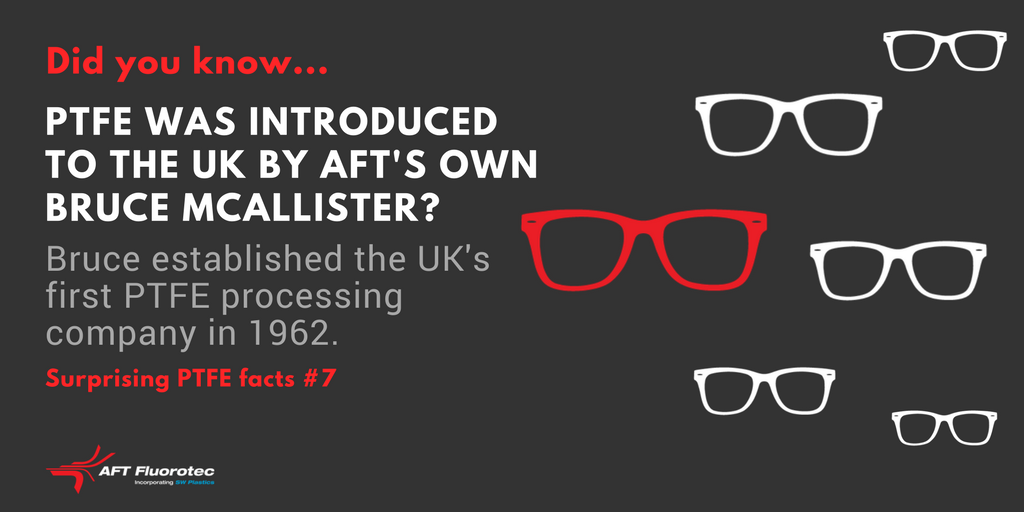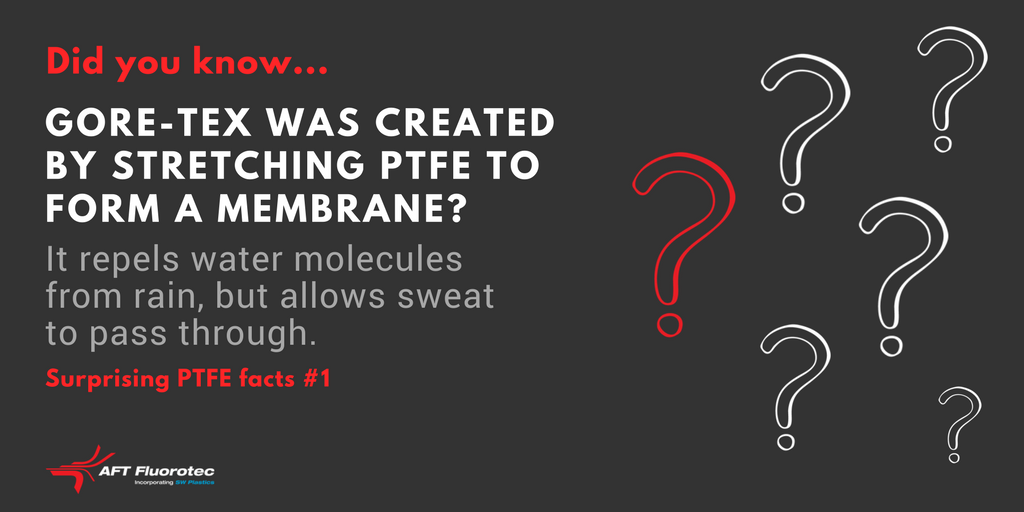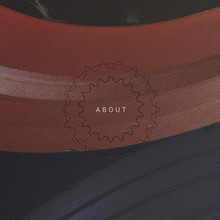Polytetrafluoroethylene or PTFE is a particularly versatile ivory-white and opaque plastic fluoropolymer; it is made by the free-radical polymerisation of many tetrafluoroethene molecules, and is suitable for a wide range of applications in industries as diverse as aerospace, the food and drink industry, pharmaceuticals and telecoms.
PTFE is commonly known as Teflon™ (owned by Chemours) and offers remarkable nonstick properties in cookware applications such as kitchen pans and baking trays.
PTFE is produced by AFT Fluorotec in rods or tubes of any size, or filled with glass, carbon, stainless steel or many other materials to increase wear resistance and strength, whatever your project or build, we are sure to have a material that will work for you.

The Main Properties of PTFE
If you were trying to invent a highly flexible, chemical resistant, thermal resistant, non-stick and electrically resistant material, and it hadn’t already been done, you’d be hoping you could come up with a material somewhere nearly as good as PTFE is in these areas.
PTFE’s melting point is around 327°C, and pure PTFE is almost totally chemically inert, highly insoluble in most solvents or chemicals, and thermally stable enough to be used between -200 degrees C and +260 degrees C without degrading.
Other useful PTFE properties are its high flexural strength, even in low temperatures, high electrical resistance and dielectric strength, resistance to water (owing to fluorine’s high electronegativity), and low coefficient of friction. PTFE’s density is also very high, at 2200 kg/m3.
In fact, beyond reaction to some chemical agents and solvents (for example, chlorine trifluoride, cobalt(III) fluoride, xenon difluoride or elementary fluorine if at a high pressure and temperature), the only factor to be taken into consideration when using PTFE is that it does not have a good resistance to high energy radiation, which will cause breakdown of the PTFE molecule.
Modified PTFE properties
In addition to pure PTFE, there are two co-polymers which are equally as useful as PTFE, but with some different properties.
PFA or Perfluoroalkoxy has very similar properties to PTFE in that it is very chemically resistant, flexible and thermally stable (with continuous use up to 260 degrees C), but while PTFE does have some tendency to creep, PFA is creep resistant and is excellent for melt-processing, injection moulding, extrusion, compression moulding, blow moulding, and transfer moulding.
TFM, known as PTFE-TFM, is polytetrafluoroethylene with perfluoropropylvinylether as an additional modifier, giving a denser material which is stiffer, also creep resistant like PFA, and weldable.
Filled PTFE
Pure or virgin PTFE can deform badly under a load, but the use of fillers can help with this, though it should be noted that not all filled PTFE is suitable for use with food.
Adding a filler to PTFE can increase its strength, improve resistance to abrasion, add electrical conductivity and more; however, adding fillers can also reduce some of the advantageous PTFE properties, such as chemical resistance which will be limited by that of the filler.
Fillers used can range from glass in various percentages, stainless steel, molybdenum disulphide, carbon or graphite, depending on which properties are to be improved.
Advantages and benefits of using PTFE
The biggest advantage of PTFE is its versatility, and the range of applications over so many products and different industries for this material is staggering.
The use of PTFE can have massive benefits in manufacturing and engineering, not just in making tubes or liners for handling or storing corrosive chemicals, but by coating parts such as bearings or screws to increase the lifetime of both the parts themselves and the machinery they are part of.
A PTFE-coated screw will be resistant to corrosion, due to PTFE’s ability to repel water and oil, and lubricated by the material to smoothly drive into whatever surface you are fastening to, with reduced friction, resulting in less wear on both the screw and the surface, and a longer-lasting, more secure finish.
Friction and wear can also be factors with bearings, and a PTFE coat can give the same benefits as with coating screws, with the additional advantage that the coating will also be heat-resistant.
It’s clear that longer lasting, higher-performance parts can add to the efficiency of any machinery, reduce the need to constantly acquire replacement parts, both saving money and the time needed to fit the replacements, as well as reducing waste. This will also reduce maintenance needs as there are less likely to be faults with the equipment, and also greatly reduce, or even eliminate, any expensive manufacturing downtime due to faults or repairs.
Cleaning of equipment can also be reduced in some cases as a PTFE coat is non-wetting, facilitating self-cleaning of parts.
And Teflon textile finishes can even help the environment, because, when applied to fabric, the finish will repel water and oil stains, reducing the need to use dry cleaning, and fabrics will also dry more quickly, using less energy with tumble drying, and last longer due to reduced wear.
With the added advantages that PTFE is non-toxic, has only a minor contraindication for humans from polymer fume fever (only if the temperature of any Teflon-coated pans reaches 260 degrees C) and is FDA approved and food-safe, this material really is of great benefit in many different areas.
Interesting uses of PTFE
As well as coating everything from pans to bearings, PTFE is also used to stop insects climbing walls as the material is so ‘non-stick’ that insects (and even geckos) are unable to grip.
The polymer is used frequently as a coating on catheters to inhibit bacteria and infections and is also used as a graft material in surgery.
You’ll have heard of Gore-Tex, and it’s PTFE again, this time as a thin, porous membrane to make breathable rainwear, or for medical implants, wiring insulation and sealants.

Bearing in mind that PTFE was discovered by happy accident in 1938, it’s difficult to imagine our world today without it.
If you’re interested in using PTFE for any of your projects, or if you’d like to find out more information about the properties of PTFE, please do get in touch and we’d be happy to talk you through your options.



